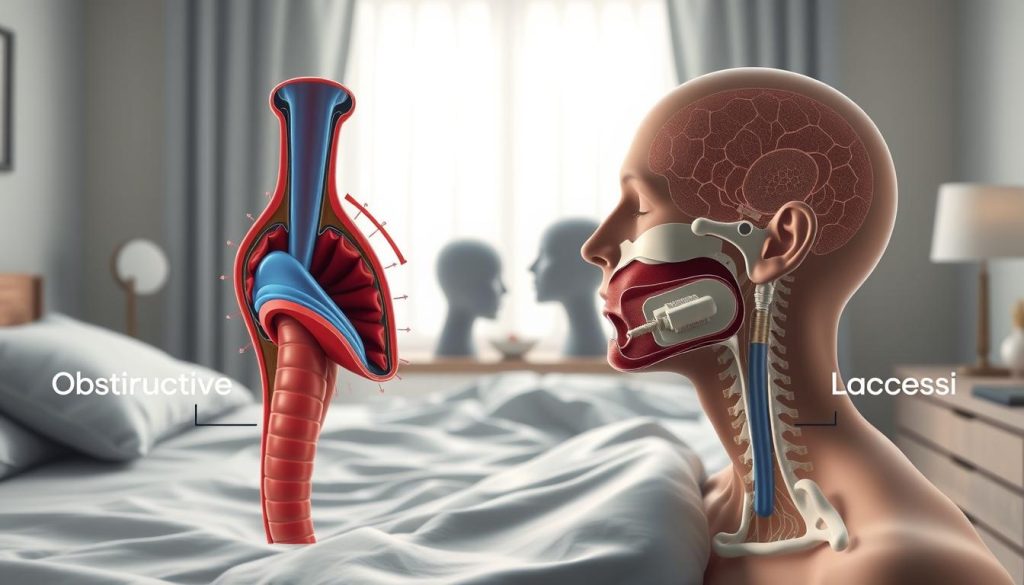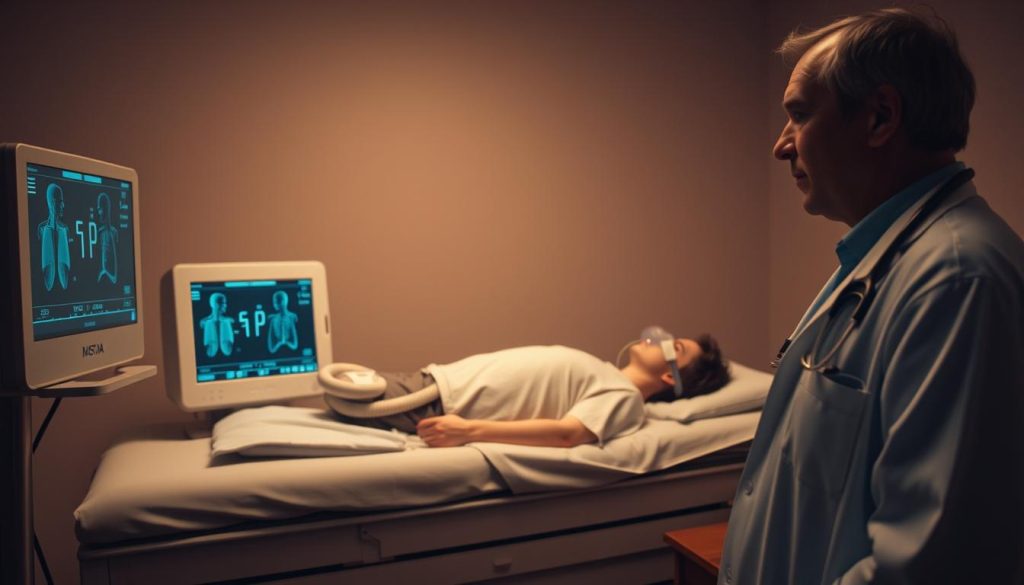Sleep apnea is a condition where breathing repeatedly stops and starts during rest. These pauses can last for seconds or even minutes, disrupting your sleep and affecting your overall health. If left untreated, it can lead to serious complications like high blood pressure, heart problems, and daytime fatigue.
There are two main types: obstructive sleep apnea, caused by blocked airways, and central sleep apnea, which occurs when the brain fails to send proper signals to the muscles that control breathing. Understanding these differences is crucial for finding the right treatment.
This article will explore the causes, symptoms, and effective management strategies for sleep apnea. With proper care and guidance from healthcare providers, it’s possible to improve your sleep quality and overall well-being.
Understanding Sleep Apnea
This condition involves repeated interruptions in breathing while sleeping. These pauses can last a few seconds or longer, disrupting rest and affecting overall health. Recognizing the signs early can help manage its impact effectively.
What is Sleep Apnea?
Sleep apnea is a breathing disorder that occurs during rest. It causes abnormal breathing patterns, leading to frequent pauses. These interruptions can reduce oxygen levels and wake a person up multiple times at night.
There are two main types: obstructive and central sleep apnea. While obstructive involves blocked airways, central sleep apnea happens when the brain fails to send proper signals to breathing muscles.
Overview and Impact on Health
Repeated breathing pauses can harm your health in several ways. They disrupt sleep quality, leaving you tired during the day. Over time, this can increase the risk of serious health issues like high blood pressure and heart problems.
Sleep partners often notice symptoms like loud snoring or gasping for air. However, self-diagnosing can be challenging since these events occur during sleep. Understanding the basics of this condition is key to seeking timely help.
- Defines sleep apnea as a breathing disorder.
- Explains how it disrupts rest and affects daily life.
- Highlights the role of sleep partners in identifying symptoms.
- Emphasizes the importance of professional diagnosis.
Key Differences Between Obstructive and Central Sleep Apnea
Obstructive and central sleep apnea are two distinct conditions with unique underlying causes. While both disrupt breathing during rest, their mechanisms and treatment approaches differ significantly. Understanding these differences is crucial for effective management and improved health outcomes.

Defining Obstructive Sleep Apnea
Obstructive sleep apnea occurs when the airway becomes partially or completely blocked during sleep. This blockage often results from relaxed throat muscles or excess tissue in the airway. As a result, breathing pauses repeatedly, leading to reduced oxygen levels and frequent awakenings.
This condition is often associated with loud snoring and daytime fatigue. Over time, it can increase the risk of high blood pressure and heart-related issues. Treatment typically focuses on keeping the airway open through devices like CPAP machines or oral appliances.
Understanding Central Sleep Apnea
Central sleep apnea, on the other hand, is linked to the brain’s inability to send proper signals to the muscles that control breathing. Unlike obstructive sleep apnea, there is no physical blockage. Instead, the issue lies in the central nervous system.
This type of sleep apnea is less common but can still significantly impact heart health and overall well-being. Treatment often involves addressing the underlying neurological condition or using adaptive servo-ventilation devices to regulate breathing patterns.
- Obstructive sleep apnea involves airway blockage, while central sleep apnea is related to brain signal issues.
- Both types can lead to serious health complications, including high blood pressure and heart problems.
- Treatment approaches vary based on the underlying cause of the condition.
Causes of sleep apnea
Breathing disruptions during rest can stem from both physical and neurological factors. These triggers often work together, leading to repeated pauses in breathing and reduced oxygen levels. Recognizing these causes is essential for effective management and treatment.
Mechanical Triggers
Mechanical triggers involve physical blockages in the airway. When throat muscles relax during sleep, they can collapse and obstruct airflow. This is common in obstructive sleep apnea, where excess tissue or anatomical issues contribute to the problem.
Such blockages can lead to loud snoring and frequent awakenings. Over time, they may also cause significant drops in blood oxygen levels, increasing the risk of health complications.
Neurological Triggers
Neurological triggers occur when the brain fails to send proper signals to the muscles that control breathing. This is a hallmark of central sleep apnea, where there is no physical blockage. Instead, the issue lies in the central nervous system.
These signal failures can disrupt breathing patterns and reduce oxygen levels. Unlike mechanical triggers, neurological issues require different treatment approaches, often focusing on the brain’s role in breathing regulation.
| Trigger Type | Description | Common Symptoms |
|---|---|---|
| Mechanical | Physical blockages in the airway, often due to relaxed throat muscles or excess tissue. | Loud snoring, frequent awakenings, daytime fatigue. |
| Neurological | Brain signal failures that disrupt breathing muscle control. | Irregular breathing patterns, reduced oxygen levels, sleep disturbances. |
Both mechanical and neurological triggers can significantly impact rest quality and overall health. Understanding their differences helps in choosing the right treatment and management strategies.
Risk Factors and Warning Signs
Certain factors can significantly increase the likelihood of developing breathing disruptions during rest. Recognizing these risks early can help prevent serious health complications and improve quality of life.
Obesity, Anatomical Factors, and Family History
Obesity is a major risk factor, especially in adults and children. Excess weight can lead to airway obstruction by putting pressure on the throat. This makes it harder for oxygen to flow properly during rest.
Anatomical factors, such as a narrow throat or enlarged tissues, also play a role. These physical traits can block airflow, causing repeated pauses in breathing. Family history is another key factor, as inherited anatomical structures can predispose individuals to these issues.
Other Lifestyle-Related Risks
Lifestyle choices can worsen symptoms or increase susceptibility. Smoking irritates the throat and can cause inflammation, narrowing the airway. Alcohol relaxes the muscles in the throat, making it easier for them to collapse during rest.
Early recognition of these risk factors and warning signs is crucial. If you or a loved one experiences symptoms like loud snoring or daytime fatigue, seek medical evaluation promptly. Addressing these factors early can lead to better outcomes and improved health.
Recognizing the Symptoms of Sleep Apnea
Identifying symptoms of nighttime breathing issues is crucial for effective management. These signs often go unnoticed but can significantly impact daily life and overall health. Recognizing them early can lead to timely intervention and better outcomes.
Excessive Daytime Sleepiness and Snoring
One of the most common symptoms is excessive daytime sleepiness. This occurs because frequent breathing pauses disrupt rest, leaving individuals feeling tired even after a full night’s sleep. It can affect concentration, productivity, and overall quality of life.
Loud and disruptive snoring is another key sign, often noticed by a sleep partner. While snoring alone doesn’t always indicate a problem, it can be a red flag when combined with other symptoms like gasping or choking during rest.
Other accompanying symptoms include:
- Morning headaches due to reduced oxygen levels.
- Difficulty concentrating or memory issues.
- Irritability or mood swings caused by poor rest quality.
The frequency and severity of these symptoms can serve as indicators for further medical diagnosis. If you or someone in your family experiences these signs, it’s important to observe and document them. Discussing these details with a healthcare provider can help determine the next steps for evaluation and treatment.
How Sleep Apnea is Diagnosed
Accurate diagnosis is the first step toward managing nighttime breathing issues effectively. Identifying the root cause and severity of the condition helps healthcare providers recommend the best treatment plan. Two primary methods are used: in-lab sleep studies and at-home testing.

In-Lab Sleep Studies
In-lab sleep studies, also known as polysomnography, provide a detailed analysis of sleep patterns and breathing interruptions. During the test, sensors monitor oxygen levels, muscle movement, and brain activity. This helps identify pauses in breathing and their impact on rest quality.
Benefits of in-lab studies include:
- Comprehensive data collection for accurate diagnosis.
- Ability to monitor multiple sleep stages and detect subtle issues.
- Professional supervision ensures precise results.
At-Home Testing
At-home sleep tests offer convenience and accessibility for individuals with a high pre-test probability of breathing disruptions. These tests use portable devices to track oxygen levels, muscle activity, and breathing patterns in the comfort of your own bed.
Key advantages of at-home testing include:
- Ease of use and reduced stress compared to in-lab studies.
- Cost-effective option for initial screening.
- Ability to sleep in a familiar environment for more natural results.
Both methods require professional interpretation of results to determine the severity of the condition and plan appropriate treatment. Choosing the right diagnostic approach depends on individual needs and the complexity of symptoms.
Treatment Options and Management Strategies
Effective management of nighttime breathing disruptions involves a range of treatment options tailored to individual needs. These strategies aim to improve rest quality, reduce symptoms, and lower the risk of complications like high blood pressure. Consulting a healthcare provider is essential to determine the best approach for your specific condition.
Positive Airway Pressure and Oral Appliances
Positive airway pressure (PAP) therapy is the gold standard for treating obstructive breathing disruptions. Devices like CPAP and BiPAP deliver steady air pressure to keep the airway open during rest. This helps prevent pauses in breathing and ensures proper oxygen flow.
For those who find PAP devices uncomfortable, oral appliances can be a viable alternative. These custom-fitted devices reposition the tongue and jaw to maintain an open airway. They are particularly effective for mild to moderate cases.
Surgical and Medication Approaches
Surgical options may be recommended for severe anatomical obstructions. Procedures like tissue removal or implants can help widen the airway and improve breathing. These interventions are typically considered when other treatments are ineffective.
Medication approaches are emerging as a promising solution, especially for obesity-related cases. Recent FDA approvals, such as Zepbound, target weight management to reduce airway pressure and improve symptoms. Always consult your doctor to explore these options.
| Treatment | Description | Best For |
|---|---|---|
| PAP Therapy | Uses devices like CPAP or BiPAP to deliver air pressure and keep the airway open. | Moderate to severe cases. |
| Oral Appliances | Custom-fitted devices that reposition the tongue and jaw to maintain airflow. | Mild to moderate cases or PAP discomfort. |
| Surgery | Procedures like tissue removal or implants to widen the airway. | Severe anatomical obstructions. |
| Medication | Emerging treatments targeting weight management to reduce airway pressure. | Obesity-related cases. |
Personalized treatment plans are key to managing nighttime breathing disruptions effectively. Work closely with your healthcare provider to find the best solution for your needs and improve your overall health.
Adopting Practical Lifestyle Changes
Making small but impactful changes to your daily habits can significantly improve your sleep quality and overall health. These adjustments not only help manage symptoms but also reduce the risk of complications like high blood pressure. Combining lifestyle changes with medical treatments can lead to better outcomes.

Weight Management and Exercise
Maintaining a healthy weight is crucial for reducing the severity of nighttime breathing disruptions. Excess weight can put pressure on the throat, narrowing the airway and increasing the risk of pauses in breathing. Regular exercise helps with weight loss and strengthens the muscles that support the airway.
Here are some practical tips to get started:
- Aim for at least 30 minutes of moderate exercise, like walking or swimming, most days of the week.
- Focus on a balanced diet rich in fruits, vegetables, and lean proteins to support weight management.
- Consult a healthcare provider for personalized exercise and nutrition plans.
Optimizing Your Sleep Environment
Creating a sleep-friendly environment can make a big difference in your rest quality. Reducing disruptions like noise and light helps you stay asleep longer. Adjusting room temperature and using comfortable bedding can also promote better sleep.
Consider these simple changes:
- Keep your bedroom cool, quiet, and dark to minimize disturbances.
- Use blackout curtains or a white noise machine if needed.
- Avoid screens and caffeine close to bedtime to improve sleep readiness.
By adopting these lifestyle changes, you can complement medical treatments and improve your overall health. Small steps today can lead to better sleep and a healthier tomorrow.
Final Thoughts on Managing Sleep Apnea
Addressing nighttime breathing disruptions requires a proactive approach. Early diagnosis and consistent management can significantly improve your quality of life. Adults experiencing daytime sleepiness or other symptoms should seek professional help promptly.
Lifestyle changes, like weight management and optimizing your sleep environment, play a key role. Combining these adjustments with treatments such as PAP therapy or oral appliances can yield long-term benefits. Regular monitoring and follow-ups with healthcare providers ensure the problem stays under control.
Taking small steps today can lead to better rest and overall health. Don’t ignore the signs—prioritize your well-being and take action to improve your sleep habits.

